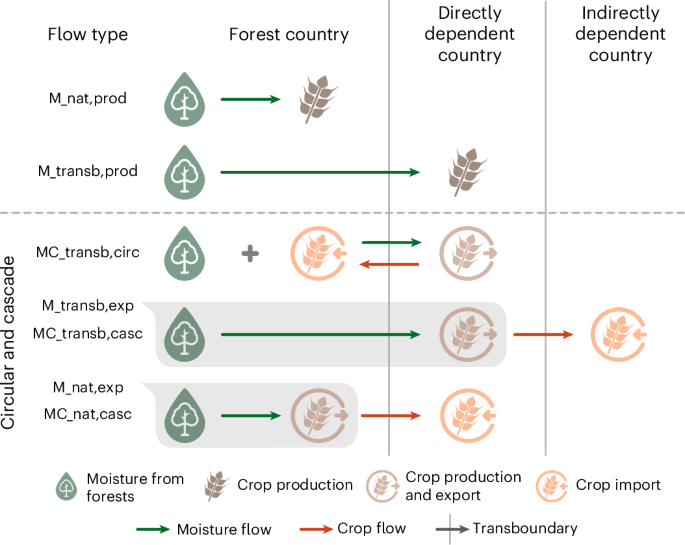Report on Innovations in Infant Nutrition and Alignment with Sustainable Development Goals
Introduction: Advancing Infant Health through Nutrition Science
The infant probiotics market is undergoing significant expansion, driven by scientific advancements in microbiome research and heightened parental awareness regarding the foundational role of gut health in overall well-being. This report details current innovations in infant nutrition, with a specific focus on how these developments contribute to achieving the United Nations Sustainable Development Goals (SDGs), particularly SDG 3 (Good Health and Well-being).
Market Dynamics and Contribution to Global Health (SDG 3)
Drivers of Market Expansion
The growth of the infant nutrition sector is primarily influenced by two factors that directly support the objectives of SDG 3:
- Increased Parental Knowledge: Modern parents are highly informed, actively seeking clinically substantiated nutritional solutions to establish a foundation for lifelong health, viewing early-life gut health as a critical investment in their child’s well-being.
- Advancing Microbiome Science: Ongoing research provides deeper insights into the infant gut, enabling the development of targeted probiotic and prebiotic formulations that address specific health needs from birth.
Consumer Trends and Responsible Consumption (SDG 12)
Consumer demand is shifting towards products that align with principles of transparency and efficacy, reflecting a move towards more responsible consumption patterns as outlined in SDG 12.
- Demand for Substantiation: Consumers now expect clear clinical evidence to support health claims, moving beyond generic statements to demand proven, strain-specific benefits.
- Preference for Natural and Safe Solutions: There is a pronounced demand for natural ingredients with strong safety profiles, such as Human-Residential Bifidobacteria (HRB) strains, which are inherently compatible with the infant gut.
Scientific Innovation and Industry Advancement (SDG 9)
Advances in Microbiome Research
Technological and scientific progress is fundamental to creating next-generation infant formulas, contributing to SDG 9 (Industry, Innovation, and Infrastructure) by enhancing research and upgrading technological capabilities.
- Genomic and AI-Driven Insights: Large-scale genomic studies, metagenomics, and Artificial Intelligence are enabling researchers to understand the role of “pioneer” bacteria, predict the functionality of specific probiotic strains, and map the infant gut ecosystem.
- Identifying Microbiome Gaps: Recent studies have revealed significant deficiencies in key microbes, such as Bifidobacterium longum subs. infantis, in a large percentage of infants. This insight drives the development of targeted formulations to restore a healthy microbiome.
- Personalized Nutrition: The trajectory of current research points toward the future development of personalized probiotic therapies, where formulations are matched to an infant’s specific microbiome profile for optimal health outcomes.
Key Ingredient Innovations
Ingredient innovation is focused on replicating the complex benefits of breast milk to provide comprehensive health support.
- Human Milk Probiotics: Strains isolated directly from human breast milk, such as Hereditum LC40, are being utilized to pioneer early microbial colonization and guide the development of the neonatal gut, with clinical trials supporting their benefits for diverse infant populations, including those born via C-section and pre-term babies.
- Prebiotics: Galacto-oligosaccharides (GOS) are widely used due to extensive clinical evidence supporting their ability to promote the growth of beneficial gut bacteria. Innovation is now focused on combining GOS with other components like Human Milk Oligosaccharides (HMOs) to enhance oligosaccharide diversity.
- Synbiotic and Holistic Formulations: The industry is moving towards holistic solutions that combine prebiotics, probiotics, HMOs, and other supportive ingredients like lactoferrin and omega-3s. These synergistic combinations more closely mimic the functional profile of breast milk, offering comprehensive support for gut health and immune development.
Strategic Alignment with SDG 3: Good Health and Well-being
Enhancing Infant Health to Reduce Child Mortality
The primary objective of these nutritional innovations is to improve infant health outcomes, directly contributing to SDG Target 3.2, which aims to end preventable deaths of newborns and children under five years of age. By developing formulas that closely mimic breast milk, the industry provides critical nutritional support for infants when breastfeeding is not an option, ensuring they receive a healthy start in life.
Targeted Health Outcomes
The development of advanced infant nutrition delivers specific, evidence-based health benefits that are crucial for achieving long-term well-being.
- Immune System Development: Early administration of appropriate probiotic strains helps mature the immune system, potentially reducing the long-term risk of allergies and autoimmune conditions.
- Digestive Health and Comfort: Targeted formulations support gut comfort and function, which is especially critical for vulnerable groups such as premature infants.
- Healthy Growth and Development: A balanced gut microbiome supports nutrient absorption and is linked to healthy growth, brain development, and cognitive function.
- Foundation for Lifelong Health: Establishing a healthy gut microbiota in infancy is associated with a reduced risk of obesity and other non-communicable diseases later in life, promoting well-being across the entire life course.
Conclusion: The Future of Infant Nutrition and Global Goals
The infant nutrition industry is evolving from single-ingredient solutions to complex, synergistic formulations grounded in robust scientific evidence. This progress is not only meeting the demands of informed consumers but is also making a substantial contribution to global public health objectives. By focusing on the foundational importance of the early-life microbiome, these innovations directly support the achievement of SDG 3 (Good Health and Well-being) and contribute to SDG 2 (Zero Hunger) by combating malnutrition in all its forms. The continued emphasis on research and development promises a future of increasingly personalized and effective nutritional solutions for infants worldwide.
Analysis of Sustainable Development Goals in the Article
1. Which SDGs are addressed or connected to the issues highlighted in the article?
The article on the infant probiotics market connects to several Sustainable Development Goals (SDGs) by focusing on improving infant health, nutrition, and leveraging scientific innovation.
-
SDG 2: Zero Hunger
This goal aims to end hunger, achieve food security, improve nutrition, and promote sustainable agriculture. The article directly relates to the “improve nutrition” aspect by discussing innovations in infant formula designed to enhance the nutritional intake and gut health of infants, which is crucial for preventing malnutrition in early life. The development of formulas that mimic breast milk contributes to ensuring infants receive the best possible nutrition when breastfeeding is not an option.
-
SDG 3: Good Health and Well-being
This is the most prominent SDG in the article. The entire discussion revolves around promoting health and well-being for infants. It details how advanced probiotics, prebiotics, and other ingredients support a healthy gut microbiome, which in turn strengthens the immune system, reduces the risk of allergies and autoimmune conditions, and supports overall healthy growth and development from the earliest stage of life.
-
SDG 9: Industry, Innovation, and Infrastructure
This goal focuses on building resilient infrastructure, promoting inclusive and sustainable industrialization, and fostering innovation. The article is a clear showcase of this SDG in action within the nutrition industry. It highlights significant investment in scientific research (microbiome, genomics, AI), technological advancements in food science, and the development of innovative products (strain-specific probiotics, synbiotics) by various companies to solve health-related challenges.
2. What specific targets under those SDGs can be identified based on the article’s content?
Based on the article’s focus, the following specific SDG targets can be identified:
-
Target 2.2: End all forms of malnutrition
The article addresses this target by focusing on improving the quality of infant nutrition. The text explains that a healthy gut microbiome, supported by probiotics and prebiotics, can lead to “healthy growth through improved mineral absorption.” Innovations aim to create infant formulas that “replicate the functional benefits of breast milk,” directly tackling the nutritional needs of infants to prevent deficiencies and ensure proper development.
-
Target 3.2: End preventable deaths of newborns and children under 5 years of age
While not mentioning mortality directly, the article’s content is fundamental to this target. It emphasizes how a healthy gut microbiome supports “immune system maturation and overall health in early life.” By strengthening an infant’s immune system, these nutritional products help protect against infections and diseases, which are major causes of infant mortality. The article also notes that certain probiotics can reduce the risk of conditions affecting “vulnerable groups” like “pre-term babies.”
-
Target 3.4: Reduce by one third premature mortality from non-communicable diseases (NCDs) through prevention and treatment and promote mental health and well-being
The article connects early-life nutrition to long-term health outcomes. It states that the “early administration of compatible HRB strains has been shown to reduce the risk of allergies, obesity, and autoimmune conditions.” Obesity is a major risk factor for many NCDs later in life. Furthermore, it mentions that a healthy gut can support “mental well-being,” aligning with the promotion of mental health aspect of this target.
-
Target 9.5: Enhance scientific research, upgrade the technological capabilities of industrial sectors… encouraging innovation
The article is replete with examples that align with this target. It describes how “advancing microbiome research” and “large-scale genomic studies” are “profoundly shaping” product development. The mention of “metagenomics and AI developments” being used to “predict specific strains’ functionality” and the creation of novel formulations like “synbiotics” and “human milk probiotics” by companies such as Kerry, Novonesis, and Morinaga Milk are direct evidence of enhanced research and innovation within the industry.
3. Are there any indicators mentioned or implied in the article that can be used to measure progress towards the identified targets?
The article implies several qualitative and quantitative indicators that can be used to measure progress:
-
Indicators for SDG 2 & 3 (Nutrition and Health)
- Prevalence of beneficial gut bacteria: The article cites a US study showing “over 90% [of infants] lacked B. longum subs. infantis.” Measuring the presence of such key microbes in infant populations can serve as an indicator of gut health and nutritional status.
- Reduction in the risk of specific health conditions: The article claims that certain probiotics can reduce the risk of “allergies, obesity, and autoimmune conditions.” Tracking the incidence and prevalence of these conditions in infant and child populations could be an indicator of the impact of improved nutrition.
- Clinical trial outcomes: The emphasis on “clinical evidence” and the mention of “several clinical trials” and “over 70 clinical trials” for specific ingredients suggest that data from these studies (e.g., improved immune markers, growth rates, reduced digestive issues) are key indicators of product efficacy and contribution to health.
-
Indicators for SDG 9 (Innovation)
- Market penetration of innovative ingredients: The article provides a specific data point from Innova Market Insights that “half of infant milk formulas worldwide contain GOS, and 57% of new launches in 2025 featured these ingredients.” This percentage serves as a direct, quantifiable indicator of the adoption of research-backed innovation in the industry.
- Development of new, targeted products: The introduction of specific, named products like “Hereditum LC40,” “Vivinal GOS,” and the “Triple Bifidus Combination” represents milestones in innovation. The number and sophistication of such new product launches can be tracked as an indicator.
- Application of advanced research technologies: The use of “metagenomics and AI” in research is mentioned as a key driver. The adoption rate and investment in these advanced technologies within the nutrition industry can be an indicator of progress towards enhancing technological capabilities.
4. Table of SDGs, Targets, and Indicators
| SDGs | Targets | Indicators Identified in the Article |
|---|---|---|
| SDG 2: Zero Hunger | 2.2: End all forms of malnutrition. |
|
| SDG 3: Good Health and Well-being | 3.2: End preventable deaths of newborns and children under 5 years of age. |
|
| 3.4: Reduce premature mortality from NCDs and promote mental well-being. |
|
|
| SDG 9: Industry, Innovation, and Infrastructure | 9.5: Enhance scientific research and encourage innovation. |
|
Source: nutritioninsight.com







